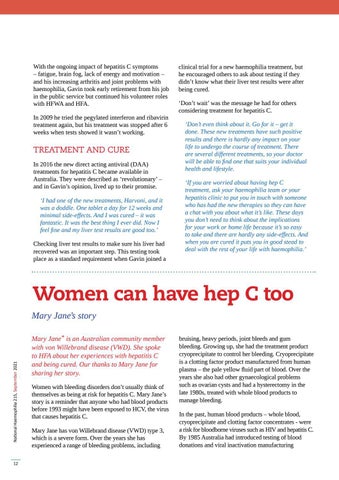With the ongoing impact of hepatitis C symptoms – fatigue, brain fog, lack of energy and motivation – and his increasing arthritis and joint problems with haemophilia, Gavin took early retirement from his job in the public service but continued his volunteer roles with HFWA and HFA. In 2009 he tried the pegylated interferon and ribavirin treatment again, but his treatment was stopped after 6 weeks when tests showed it wasn’t working.
TREATMENT AND CURE In 2016 the new direct acting antiviral (DAA) treatments for hepatitis C became available in Australia. They were described as ‘revolutionary’ – and in Gavin’s opinion, lived up to their promise. ‘I had one of the new treatments, Harvoni, and it was a doddle. One tablet a day for 12 weeks and minimal side-effects. And I was cured – it was fantastic. It was the best thing I ever did. Now I feel fine and my liver test results are good too.’ Checking liver test results to make sure his liver had recovered was an important step. This testing took place as a standard requirement when Gavin joined a
clinical trial for a new haemophilia treatment, but he encouraged others to ask about testing if they didn’t know what their liver test results were after being cured. ‘Don’t wait’ was the message he had for others considering treatment for hepatitis C. ‘Don’t even think about it. Go for it – get it done. These new treatments have such positive results and there is hardly any impact on your life to undergo the course of treatment. There are several different treatments, so your doctor will be able to find one that suits your individual health and lifestyle. ‘If you are worried about having hep C treatment, ask your haemophilia team or your hepatitis clinic to put you in touch with someone who has had the new therapies so they can have a chat with you about what it’s like. These days you don’t need to think about the implications for your work or home life because it’s so easy to take and there are hardly any side-effects. And when you are cured it puts you in good stead to deal with the rest of your life with haemophilia.’
Women can have hep C too
National Haemophilia 215, September 2021
Mary Jane’s story
12
Mary Jane* is an Australian community member with von Willebrand disease (VWD). She spoke to HFA about her experiences with hepatitis C and being cured. Our thanks to Mary Jane for sharing her story. Women with bleeding disorders don’t usually think of themselves as being at risk for hepatitis C. Mary Jane’s story is a reminder that anyone who had blood products before 1993 might have been exposed to HCV, the virus that causes hepatitis C. Mary Jane has von Willebrand disease (VWD) type 3, which is a severe form. Over the years she has experienced a range of bleeding problems, including
bruising, heavy periods, joint bleeds and gum bleeding. Growing up, she had the treatment product cryoprecipitate to control her bleeding. Cryoprecipitate is a clotting factor product manufactured from human plasma – the pale yellow fluid part of blood. Over the years she also had other gynaecological problems such as ovarian cysts and had a hysterectomy in the late 1980s, treated with whole blood products to manage bleeding. In the past, human blood products – whole blood, cryoprecipitate and clotting factor concentrates - were a risk for bloodborne viruses such as HIV and hepatitis C. By 1985 Australia had introduced testing of blood donations and viral inactivation manufacturing















